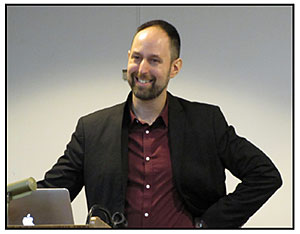Music Educators Association of New Jersey
Serving teachers and students since 1927



Treating muscle memory as a friend and a foe is the best route to solid memory. The most effective techniques in strengthening memory, according to concert pianist Spencer Myer, are those that change your routine physical sensation, essentially removing the “autopilot” variable.
 When you are on stage performing, about 80 percent of what you do is muscle memory — with the remaining 20 percent “other.” This is the area that can solidify a performance. While muscle memory is a large part of how we prepare, we don’t want to rely completely on this. We need to engage the brain so we are thinking while we are playing.
When you are on stage performing, about 80 percent of what you do is muscle memory — with the remaining 20 percent “other.” This is the area that can solidify a performance. While muscle memory is a large part of how we prepare, we don’t want to rely completely on this. We need to engage the brain so we are thinking while we are playing.
Sometimes thinking of a distraction can bring muscle memory back; it is impossible to think of removing muscle memory. How can you make a passage feel different or foreign to your body so your brain can engage? The goal is to change how you practice and to think while you’re playing from memory. Here are some practical, successful techniques geared toward strengthening non-muscle memory, based on Spencer Myer’s own practice techniques.

WHAT CAN YOU DO AWAY FROM THE PIANO?
1. HARMONIC ANALYSIS
2. CUES: VISUAL, AURAL and PHYSICAL
 Visual: The score is your best friend. Come back to it and reinforce in your mind how it looks. You can never un-memorize a piece by looking at it; so don’t be afraid to refer to it after you have memorized it. Check the fingerings and symbols for directions, etc. The fingering is the most important to memorize. Take your time and absorb all the details.
Visual: The score is your best friend. Come back to it and reinforce in your mind how it looks. You can never un-memorize a piece by looking at it; so don’t be afraid to refer to it after you have memorized it. Check the fingerings and symbols for directions, etc. The fingering is the most important to memorize. Take your time and absorb all the details.
Aural: Know the melodies and harmonies deeply. Can you play the RH melody with your LH? Sing the melody; you will know the piece better. Sing while you practice and when away from the piano.
Physical: Dancers have an easier time remembering choreography because their whole bodies are engaged. For pianists, the more choreographed motions you incorporate, the better will be your performance. Even minor involvements, such as making small circles in phrases, e.g., which engage the wrist, whole arm and upper body reinforce memory. This is really important and ultimately helpful in performance.
PRACTICING PERFORMING
Performing on stage will always feel different from playing or practicing at home or studio. Muscle memory is not always reliable. During a performance someone in the audience who coughs could cause a distraction and a memory blip. Introducing “nerves” during practice is the best way to expose spots where our brain in not fully engaged. It is very important to practice for “nerves” — when the performance anxiety sets in. How do you do this and prepare for a performance?
WHAT TO DO BEFORE A PERFORMANCE OR AN AUDITION?
This varies with the performer. Some people don’t like to practice at all before a performance. For those who do practice:
This was such an engaging, helpful presentation that the MEA members who attended had plenty of questions and suggestions of their own for memorizing and practicing for performance! When working with students:
In a review of Spencer Myer’s performance of Bernstein’s Symphony No. 2, the reviewer said, ”Myer’s hands were a show of their own... for almost 40 minutes his fingertips seemed to have an almost electric relationship with the keyboard, while the rest of his face and body remained stoic. The effect of this deep investment in the music was hypnotizing.” We were equally hypnotized by the cameo performance Spencer gave at the end of his MEA presentation. Three pieces, from memory, In the Mist by Janáček, Chopin’s Ballade No. 3, and Poisson d’Or from Debussy’s lmages brought us to our feet in applause, admiration and appreciation of all he imparted to us that day.
Charlene Step, Writer and Page Designer
Nancy Modell, Photographer
For more information on Spencer Myer, please visit spencermyer.com.